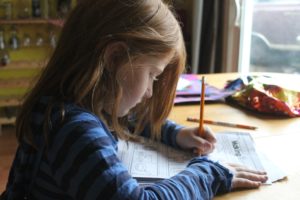
Addressing The Problem with Homework
Many educators are starting to recognize the problem with homework. And while homework is almost universal, there is little evidence that it actually works.

Ms. Claudio is the type of educator who leads with her heart. She wants to ensure every one of her students can see math connections the way she does. She knows this is how they have the greatest chance for success.
That’s why she was concerned when she first transitioned from elementary to middle school.
“The biggest challenge I faced was seeing how many students were not prepared for grade level. Only a few students in the class had mastered 5th or even 4th grade content.
“It didn’t make sense for me to start teaching 6th grade concepts when they didn’t understand the foundations.
“To meet my students’ needs, I had to revisit content going all the way back to third grade. Going over basics of times tables and fractions.
“Then, I worked forward through several grade levels. I have been teaching for 19 years, and I came from working as an elementary math coach. Without that experience, I wouldn’t have been able to understand my students’ challenges, let alone plan lessons to address them.”
It’s not uncommon for students to arrive in middle school without a firm foundation in elementary math. When students struggle in reading, schools typically notice, and make it a priority to get them up to speed. But when students struggle with math, she feels educators are more likely to focus on their innate math ability.
“Right now, students think it’s normal to ‘not be a math person.’ We haven’t created a culture and routine in our schools where math conversation is a part of everyday life.
“Schools spend a lot of time on literacy, so they are making growth. I wish K-5 schools put as much emphasis on math fluency and number sense. Working with something as simple as a number chart, you can see students struggle with fundamental concepts like ‘what’s 100 more’ or ‘what’s 20 less.’
“We would never think it was acceptable for students to not read in 6th grade. But for many students, their difficulties with number sense are the equivalent of not being able to spell or read simple sentences.
“I want to see students become savvy with numbers. Not just solving problems on paper, but becoming fluent with mental math and mathematical discourse.”
Ms. Claudio made the necessary adjustments to build numeracy in her students. But there was a limit to how much she could adjust her curriculum. This is the “One Bridge Problem” that many schools face. She believes that when we measure success only by grade-level standards, teachers’ options are limited.
“One thing I’ve learned as a teacher is how all of the content in math class connects from grade level to grade level. It’s not just disconnected ideas. So when we are doing work with fractions, I think ‘Why are we teaching fractions? How does this relate to what they learned last year? To what they’re learning next year?’”
Ms. Claudio quickly saw the benefits of using the Three Bridges Design for Learning in her classes. The second bridge, personalized learning, gives students the opportunity to work at their own level and pace. Rather than replacing her textbook or ignoring standards, she alternates curriculum coverage classes with personalized learning on Khan Academy.
“One student, ‘Anthony,’ was struggling more than my other students. He felt frustrated by grade level content. He disengaged during class, and he wasn’t doing his homework.
“His entire attitude turned around when we started using Khan Academy. At first, I asked students not to use it out of class, because I wanted to be there to support them as they were getting used to it.
“For once, Anthony was actually doing math at home. Of course, it only started when I told him not to do it for homework. He wasn’t finishing the assignments during class. But he was going home every night, doing what I had assigned, and going above and beyond. Practicing consistently, on his own time.
“I couldn’t really complain, because how can you tell a struggling student not to do extra math at home?
“Soon I could see the impact on his classwork. Working on Khan actually got him caught up to where he can now handle grade level work. He’s also taking more initiative during in class activities.”
But the benefits of personalized learning go beyond extra practice for struggling students.
“Using Khan Academy has also allowed me to assess students’ mastery of prerequisite skills. Before, the formative assessments I used would only tell me what they knew about grade level content.
“For the first time, my data is helping me understand why students are struggling. I use data from Khan Academy to understand student needs, and I plan individual lessons for specific students.
“I’ve also been able to offer accelerated content to advanced students. Without a personalized program, I wouldn’t have had the resources to challenge these students.”
Personalized learning has redefined how Ms. Claudio addresses skill-building in her math classes.
But she believes that math is more than just building skills. Inquiry-based learning helps her emphasize connections between math and the real world. It helps her students use what they learn outside the classroom.
“I find they can learn so many standards by connecting them to the real world. This fall, we went to a pumpkin patch for our fall festival.
“Students measured the field to find the area and estimate how many pumpkins grew in that field. Then, they weighed their pumpkins and found recipes online for pumpkin pie. They had to figure out how many slices of pie they could make with their pumpkin. And it all connected to our 6th grade standards: ratio and proportion, unit conversions, etc.
“Students went above and beyond because they had so much fun and could connect the math to the activities they had enjoyed.
“When they see the connections between the math they are learning and the real world, they are so much more engaged. They also learn faster, because they are seeing each concept in multiple ways.”
As a veteran educator, Ms. Claudio has developed the confidence to take risks. This helps her create meaningful math experiences for her students. But she also knows what it’s like to struggle in the classroom.
“I had a really hard time my first year. I didn’t even go to college to become a teacher. My major was broadcasting. I thought would have a career in radio or television.
“In my first year, I made a lot of mistakes. I really had no idea what I was doing. Everything came directly out of the textbook. I made classroom management mistakes. And I made relationship mistakes with my students.
“I wasn’t thinking about real world contexts, so my students weren’t engaged. They didn’t make any connection between their lives and what I was trying to teach them. After a while, it became natural for me to create meaningful experiences for students.
“Instructional coaching has been a big part of my success. I got to receive coaching from excellent teachers with a lot of experience. I also got the chance to be a coach for several years before returning to the classroom.
“One of my mentors really pushed me to close the textbook. She would ask me to talk about what I was teaching, and why I was teaching it. And I couldn’t say ‘because it’s the standard.’
“She wanted me to articulate how everything I was teaching connected to the big picture. Both for math and for their lives outside the classroom.
“Seeing math education in that form was priceless. It allowed me to become the teacher I am today. I had to let go of using the textbook as a crutch. The textbook is a tool, it’s not your end-all-be-all.
Her advice for teachers looking to move beyond the textbook?
“Think about how you can show mathematics multiple ways. Explaining is one way, but for a lot of students, and a lot of concepts, they need to be represented in multiple forms.
“Experiencing coaching from both sides has really allowed me to appreciate its benefits. And I really believe that the best professional development is working closely with other educators. Visiting their classes, planning together, having them visit your classes.”
When teachers learn from each other, students benefit.
If you’re interested in teacher coaching, the first step is reflection.
Reflection is essential for teachers preparing to work with a coach. But it’s just as important for coaches and school leaders. Coaches must reflect on their own practice. And they need to help teachers reflect on their teaching.
Our free Guide to Reflective Teaching is a great place to start. It includes self-assessments, planning guides, and other resources to support teacher coaching. Complete the guide to ensure that you and your team will get the most out of your coaching efforts.
Download the Reflective Teaching Guide

Eliset Claudio is a 6th grade math teacher in New York City public schools. She has worked previously as an elementary math teacher and teacher coach. Ms. Claudio believes that children learn best when they are empowered to take risks and explore real life math connections. She loves to connect with like-minded educators: [email protected]

Many educators are starting to recognize the problem with homework. And while homework is almost universal, there is little evidence that it actually works.

Does the Danielson Rubric improve teaching? Maybe it’s an unfair question. After all, it’s a rubric, not a training program. But…

Looking for a simple way to identify effective teaching? Consider how you (or your team) are performing in each of these three critical domains.